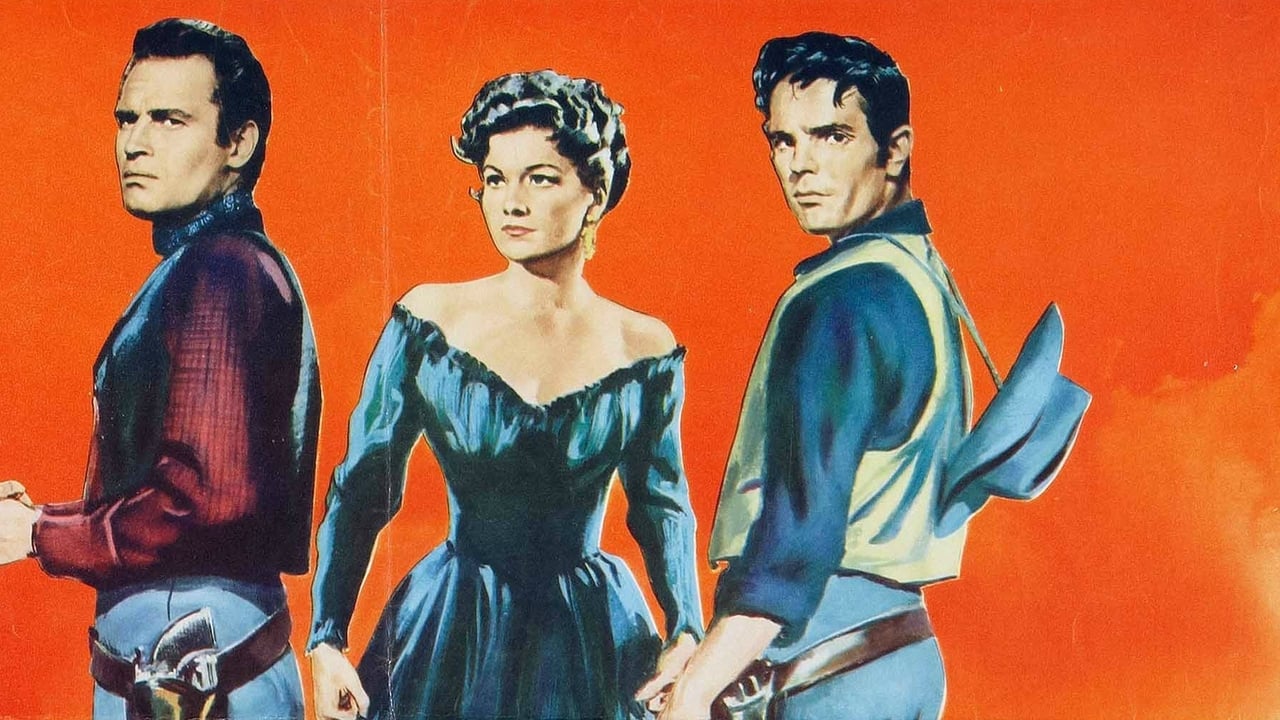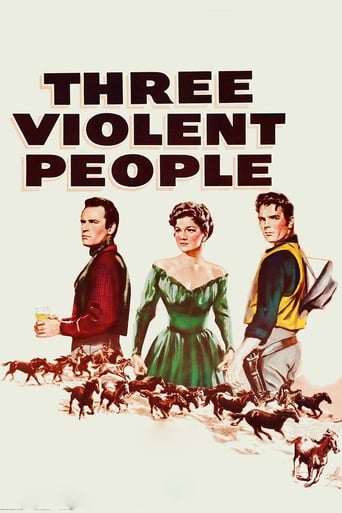



Fantastic!
Although I seem to have had higher expectations than I thought, the movie is super entertaining.
View MoreOne of the best movies of the year! Incredible from the beginning to the end.
View MoreStory: It's very simple but honestly that is fine.
Three Violent People could have been little more than an standard western about post-Civil War Texans struggling against thuggish carpetbaggers trying to take their land away -- not the commonest western plot, but we could call it "Plot Eleven". Had already been done a number of times by this movie's 1956 release, perhaps best in an unpretentious 1947 Wild Bill Elliot opus. An excellent cast headed by stalwart Carlton Heston, beautiful Anne Baxter, and the always interesting Gilbert Roland would have raised Three Violent People a cut above the average oater, even if it had been filmed in black & white or standard screen color, and it would have been an entertaining and enjoyable watch. What really made it quite a lot more than just a standard western with an overpriced staff was the gorgeous Technicolor Vista Vision cinematography.When the wide-screen craze hit in the mid-fifties, there soon were a number of competing processes, including Cinemascope, Superscope, Metroscope, 1.66:1 flat, and 1.85:1 flat. Vista Vision, pioneered by Paramount Studios, was by far the most aesthetically successful of any. Cinemascope and the later, more successful Panavision used a wide-angle lens on the camera to compress the picture into a standard 35mm frame, then a reverse lens on the projector expanded the picture so that it was 75 percent wider than the old standard 4:3 ratio screen. The "flat" widescreen processes filmed with an ordinary camera lens on standard 35 mm film but with the camera far enough back that the resulting picture could be masked at the top and the bottom to create the wide-screen effect. The problem with all of these was that the blown-up picture when projected on a large screen lost resolution, contrast, and sharpness. The loss of quality was compounded by the new less-flammable, but somewhat grainier and less transparent film with which the studios had recently replaced the old crystal-clear nitrate film, which had given us all of those beautiful, luminous black & white movies of the late 1930's and 1940's. The difference was noticeable even in Technicolor films, but it had been a minor effect until the wide-screen movies.Vista Vision was filmed with a special camera with vertical sprockets which ran the film thru sideways, creating a negative three times the area of the 35 mm print, which was masked and blown-up to widescreen with a projector aperture. The result was incredibly high resolution, sharpness, richness of color, and illusion of depth, even when projected on the largest screens.The cinematography with this wonderful and expensive process as exhibited in Three Violent people is absolutely breathtaking. It makes this movie a sensuous pleasure to watch. The clarity, color, and added sense of depth that comes through even on a wide-screen digital TV delivers an almost 3-D effect. The effect was just as strong in the indoor lamplight scenes as in the expansive views of the photogenic Arizona landscape (thinly disguised as the Texas Hill Country).Three Violent People had an intelligent if not inspired script. The dialog likewise was good, though melodramatic at times. Gilbert Roland's excesses of poetry got irritating at times. It fit with his colorful character, but could have been toned down a bit. Rudolph Mate's direction was surprisingly slow-paced, especially from one who had turned out a classic thriller like DOA. It was slow-moving in the first half, but not boring because of the strong acting and solid story development. But it really picked up after Heston discovered his wife was a shady lady, and she and his brother absconded with his valuable herd of horses. There was more melodrama than action in this one, but the action was well-staged. The runaway wagon in a stampede of horses is a western cliché, but it was much better than average executed here. Also very good was the climactic shootout with the Texas ranchers using volleys from single-shot rifles to send the Yankee baddies into headlong retreat. The sets, both inside and outside were very authentic looking. Likewise, the clothes, the rifles, revolvers, and gun leather were all unusually accurate to the late 1860's era.Overall Three Violent People was a satisfying western on every level, but most of all was simply a pleasure to watch because of the stunning Vista Vision cinematography.(Other Vista Vision Westerns: The Searchers, Gunfight at the O.K. Corral, One-Eyed Jacks)
View MoreAnne Baxter recreates her dance hall queen image in this film as she did in the 1955 picture "One Desire." The latter was far better than this. Ironically, in that one, her love interest was Clint Saunders.(Rock Hudson)In this one, she is Mrs. Saunders, married to Charlton Heston.It must have been great for Baxter and Heston to reunite after "The Ten Commandments." While this picture is a good one, it's obviously not in the same league as the DeMille masterpiece. Viewers must have certainly gone away disappointed with what they saw.The film again shows the endearing qualities of family relationships, anger and ultimate forgiveness, even when it's too late. Greed is the ultimate cause for much of the story here.Look for Jamie Farr in an almost speechless role as well as Ernest Wade, the maid, who was Sapphire in "Amos and Andy."Bruce Bennett is hopelessly miscast as the land representative sent to Texas after the Civil War. Along with his cohort, Forrest Tucker, they look to take advantage of the devastated south. In real life, Bennett had the last laugh dying at over 100 years of age a short time ago.There is a good performance by Tom Tryon as Heston's brother Cinch. Too bad we didn't see more of Tryon in films. Tryon exudes bitterness, and with his caustic personality, brings a fresh image to the film. Embittered by being one-armed, he turns to Bennett and Tucker when he is thrown out by brother Heston.
View MoreCharlton Heston made two good westerns: "The Big Country" and "Three Violent People". "Three Violent People" will show you a rousing good time. It is about a former-Confederate soldier (Charlton Heston) married to a southern belle who is hiding her former job as a saloon girl (Anne Baxter). When the husband finds out, he loses interest in his wife. Then the soldier's brother (Tom Tyron) takes over.This is Anne Baxter's best western. I think it is her only western. Tom Tryon made two more good movies: "The Cardinal" and "In Harm's Way"; then he retired in 1971 and became a successful novelist. You will notice Hollywood's best supporting actors in this movie.
View MoreWhen Cault Saunders (Charlton Heston) proposed marriage to the 'flower of the Old South,' Lorna Hunter (Anne Baxter) was completely surprised...'I'm looking for a wife, Miss Hunter. Do you want to get married?' But Lorna's answer was interrupted by Cault's long kiss...When they arrived to his ranch - already married - Lorna is introduced to Innocencio (Gilbert Roland) his Mexican right arm...When Lorna begins to familiarize with the place, Cault's brother, Cinch (Tom Tryon) appears on the scene, demanding his brother to sell portion of the ranch to any Northerner and to pay him his part in gold...Lorna was curious why Cinch is 'one-armed.' Her husband, impressed, narrated: 'We were just kids when it happened. We were horsing around on the windmill platform on the south ranch. Cinch got his arm caught in the gears of the windmill. I had to amputate his arm.'Soon, leaving the Office of the Deputy Commissioner, a stranger named Massey comes in sight... He identifies Lorna as a former saloon hostess from St. Louis... He tries to address some courteous words to her, but Lorna pretended ignorance...Cable (Forrest Tucker) insisted in pushing Massey to acknowledge Saunders about the past of his wife...Lorna admits her sin to Saunders, who was astonished... 'I'd get down on my knees if I thought it would help,' said Lorna, revealing then that she is going to have his baby...In the meantime, the government soldiers were planning for possession of the ranch, and Cinch invites his brother to a showdown...Heston is convincing as the untouchable in ethics, straight attitude toward upright conduct and honesty...Anne Baxter is excellent in her role as the tarnished woman, offended in her dignity... I remember her when preparing to leave her husband, she warns him with this great truth: 'When you're raising the boy, try to remember something. That people aren't perfect. They make mistakes. And when they do, they suffer, they pay. So when he makes his mistakes, try to find it in you to forgive him.'Tom Tryon seems reasonable, but avaricious and deceitful...Gilbert Roland will be always remembered as the Great Mexican Latin Lover of the silent and sound screen... Filmed in VistaVision and Technicolor, and directed by Rudolph Maté "Three Violent People" is an entertaining character Western in the tradition of "Duel in the Sun."
View More